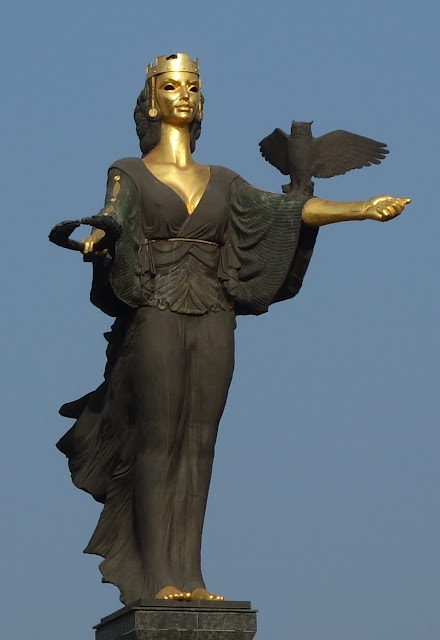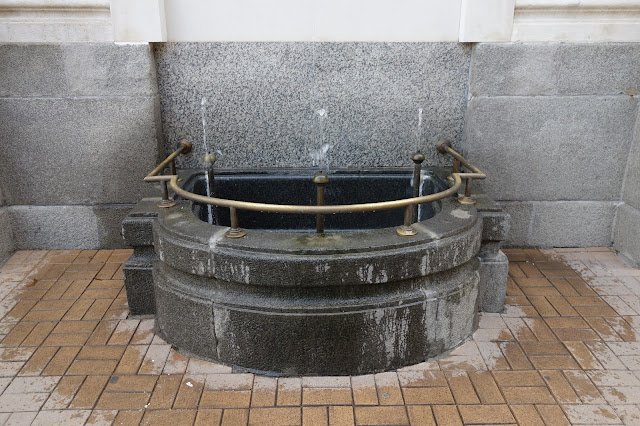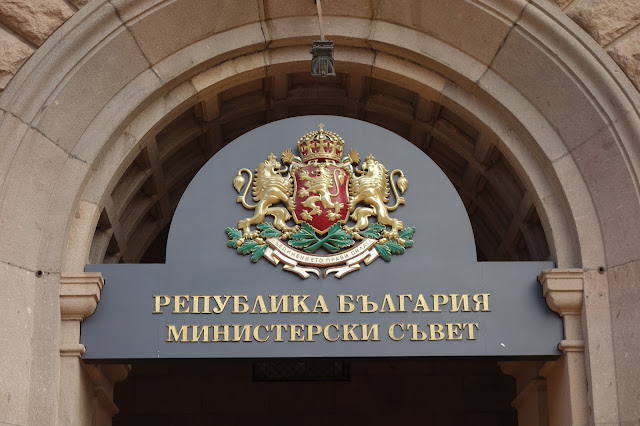we arrived in Sofia (much of which is paved in yellow brick as shown in the photo above) mid evening and were met by our driver Julian and guide George. They took us to the Grand Hotel Sofia and we got checked in, made a plan for the AM and headed to our extremely spacious room. The hotel room is very nice with a shower and tub in the marble bath and two large beds, along with a couch, easy chair and a big desk. We are scheduled for two nights here. We had a terrific meal on the Turkish Air flight from Istanbul to Sofia so we didn't need to dive into the fruit and cheese platter we had pre-ordered (just in case) but it looked yummy with several nice cheeses (and it turned out to be yummy as well when we ate it the following afternoon.)
Let me back-track just a bit. The Turkish Air flight to Istanbul had the aircraft changed from when our reservation was made and the new configuration had substantially fewer business class seats - so there was some anxiety around ensuring our business class tickets were honored but after we checked in at ORD and got our seat assignments, we relaxed. The flight took off on time at 10:40 PM and was probably the best flight I have ever been on. They have two chefs on board to handle the meals and it shows!
here are some photos of the flight food and menu-
back to the hotel- we crashed fairly soon after arriving in our room- stayed awake long enough to get the computer up and running (the end of baseball season must be attended to - LOL) and shower to rid ourselves of "road" feel....
we were up in the morning - early but not too- down to breakfast which was very nice and included some local items (various pastries and a honey comb you could eat pieces from) along with the usual coffee selections from the fancy machine (latte, capuccino, cafe au lait, chocolate and coffee blend, chocolate) - so when we met up with George we were well fed and pretty well rested.
this was like Tres Leches cake- excellent!
the honeycomb-
a great variety of honey was available each morning-
Sofia is the capital and largest city of Bulgaria. Sofia is the 15th largest city in the European Union with population of more than 1.2 million people. The city is located at the foot of Vitosha Mountain in the western part of the country, within less than 31 miles drive from the Serbian border. Its location in the centre of the Balkan peninsula means that it is the midway between the Black Sea and the Adriatic Sea, whereas the Aegean Sea is the closest sea to it.
Sofia has been an area of human habitation since at least 7000 BCE and is Europe's second-oldest city, having been founded 7000 years ago, hence the motto of the city is "Grows, but does not age". The city's earliest official mention was in the 7th century BCE.
Sofia is one of the most visited tourist destinations in Bulgaria. Among its highlights is the Alexander Nevsky Cathedral, one of the symbols of Bulgaria, constructed in the late 19th century. It can hold 10,000 people. The city is also known for the Boyana Church, a UNESCO World Heritage site.
Sofia holds Bulgaria's largest museum collections, which attract tourists and students for practical studies. The National Historical Museum in Boyana district has a vast collection of more than 650,000 historical items dating from Prehistory to the modern era, although only 10,000 of them are permanently displayed due to the lack of space. Smaller collections of items related mostly to the history of Sofia are in the National Archaeological Museum, a former mosque located between the edifices of the National Bank and the Presidency. (wikipedia)
the beautifully restored synagogue-
a little known history of how Bulgaria saved its own Jews from the Nazis has come to light now that the Soviet Union has fallen-
Bulgaria's 48,000 Jews were saved from deportation to Nazi concentration camps with the help of Dimitar Peshev, leaders of the Bulgarian Church, led by Metropolitan Stefan of Sofia, Tsar Boris, and ordinary citizens. On the eve of the planned deportations, the Bulgarian government asked for a breakdown of the German plans for the destinations of the deportees, and was told that roughly one-half would be employed in agriculture in Greater Germany and one-fourth, reported to be semi-skilled laborers, would be "allowed to redeem themselves" by "volunteering to work" in the war industries of the Ruhr Valley, while the remaining one-fourth would be transported to the General Government (German-occupied Poland) for employment in "work directly connected to the war".
Hesitating to comply with German deportation requests in late 1942 and early 1943, following rumors of mistreatment of Jews transported to Poland, the Bulgarian government made use of Swiss diplomatic channels to inquire whether it was possible to deport the Jews to British-controlled Palestine by ships across the Black Sea. However, this attempt was blocked by British Foreign Minister, Anthony Eden. Following that failure, the Bulgarian authorities permitted Germany to deport the majority of non-Bulgarian Jews residing in Bulgarian-occupied parts of Greece and Yugoslavia. None of them survived.
Although Bulgaria effectively controlled these regions immediately beyond its borders, the German authorities recognized only the Bulgarian military administration and not the civil one. Bulgaria granted citizenship to all ethnic Bulgarians living in occupied territory, and also to those of other ethnicities who wished to acquire it, with the exception of the Jews. The territories of Aegean Thrace, Macedonia and other lands controlled by Bulgaria during World War II were not considered Bulgarian although they were administered by Bulgaria. Bulgarian soldiers, assisted by German soldiers, took the Jews from Komotini and Kavala and massacred them. The Bulgarians also confiscated all of the Jewish properties and possessions. In contrast with the old Bulgarian territories, where widespread protests against the deportations took place, including petitions to the government in Sofia, in Aegean Thrace and Macedonia such organized movements were lacking.
As for the Jews in the kingdom of Bulgaria itself, German requests for their deportation to concentration camps were not complied with. Later, Bulgaria was officially thanked by the government of Israel for its defiance of Nazi Germany. This story was kept secret by the Soviet Union, because the royal Bulgarian government, the King of Bulgaria and the Church were responsible for the huge public outcry at the time, causing the majority of the country to defend its Jewish population. The communist Soviet regime could not countenance credit to be given to the former authorities, the Church, or the King, as all three were considered enemies of communism. Thus, the documentation proving the saving of Bulgaria's Jews only came to light after the end of the Cold War in 1989.
The number of 48,000 Bulgarian Jews was known to Hitler, yet not one was deported or murdered by the Nazis. The Bulgarian authorities did offer protection to Jews who were not Bulgarian nationals residing in Bulgaria proper, including those who had fled there from Nazi occupied regions in other countries. (wikipedia)
my lunch- shrimp and seaweed salad-
then it was off to a nearby burb called Boyana where we saw a spectacularly intact set of thirteenth century frescoes in the church there- admission is limited to ten minutes and groups of no more than eight to help preserve this amazing work of art - no photos inside so I will see if I can find a few on the Internet - all the follow photos were taken from a google search for Boyana frescoes-
above- the church patrons-
below St Nicholas-
these are my photos from the outside -
The Boyana Church is a medieval Bulgarian Orthodox church situated on the outskirts of Sofia, the capital of Bulgaria, in the Boyana quarter. In 1979, the building was added to the UNESCO World Heritage List. The east wing of the two-storey church was originally constructed in the late 10th or early 11th century, then the central wing was added in the 13th century under the Second Bulgarian Empire, the whole building being finished with a further expansion to the west in the middle of the 19th century. A total of 89 scenes with 240 human images are depicted on the walls of the church.
Besides the first layer of 11th-12th-century frescoes, of which only fragments are preserved, and the famous second layer of murals from 1259, the church also has a smaller number of later frescoes from the 14th and 16th-17th centuries, as well as from 1882. The church owes its world fame mainly to its frescoes from 1259. They form a second layer over the paintings from earlier centuries and represent one of the most complete and well-preserved monuments of mediaeval art in the Balkans.
Eighteen scenes in the narthex depict the life of Saint Nicholas. The painter here drew certain aspects of contemporary lifestyle. In The Miracle at Sea, the ship and the sailors' hats recall the Venetian fleet. The portraits of the patrons of the church — Sebastocrator Kaloyan and his wife Dessislava, are thought to be among the most impressive and lifelike frescoes in the church.
then we went to a terrific history museum in one of the ugliest buildings I have ever seen- a huge and horrific monstrosity of a building that was clearly built in the Soviet era -








































































